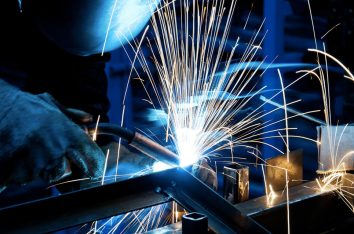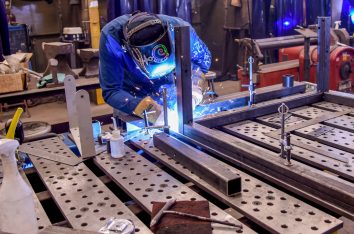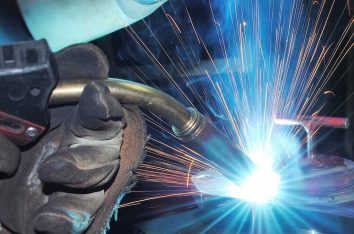Understanding the Process of Fabrication and its Various Uses
Fabrication is a cornerstone of modern manufacturing, involving the transformation of raw or semi-finished materials into functional products or components. This intricate process is essential across various industries, employing a multitude of techniques and materials to meet diverse production needs. From cutting and molding to joining and finishing, fabrication shapes the world of manufacturing, bridging the gap between concept and reality. In this article, 'Understanding the Process of Fabrication and its Various Uses,' we will explore the depth and breadth of fabrication processes and their applications in today's industrial landscape.
Key Takeaways
- Fabrication is the process of creating finished or semi-finished products from raw materials, involving various techniques like cutting, molding, and shaping.
- The process of fabrication is adaptable and can be performed manually, mechanized, or automated, with technologies such as CAD and CNC enhancing efficiency.
- Different materials and end products necessitate distinct fabrication processes, each tailored to achieve the desired characteristics and functionality.
- Fabrication is not just assembly; it encompasses the entire creation process, often starting with design and followed by multiple stages of material manipulation.
- The evolution of fabrication techniques, from traditional methods to advanced processes like 3D printing, continues to shape the future of manufacturing.
The Essence of Fabrication
Fabrication is the process of creating structures, machines, and products by cutting, shaping, and assembling various materials. It seamlessly blends artistry and engineering to craft practical and aesthetically fascinating items. Fabrication encompasses a wide range of industries, each harnessing its power to transform raw materials into finished products.
Defining Fabrication
Fabrication refers to the process of constructing items or components from standardized parts through a range of processes. It is the act of creating something from raw or semi-finished materials, often involving cutting, bending, and assembling. Fabrication can encompass a multitude of applications, from creating large structures to manufacturing intricate machine parts.
- Etymology: The term 'fabrication' originates from the Latin 'fabrication', denoting the act of making.
- Meaning: In the context of manufacturing, to fabricate means to construct or build an item from standardized parts.
Historical Context
The concept of fabrication is not new; it has been integral to human development. Fabrication involves the transformation of materials into useful items, a practice that dates back to ancient civilizations. The evolution of fabrication techniques reflects the advancement of technology and society's growing needs.
- Early Fabrication: Utilized simple tools and methods.
- Industrial Revolution: Marked a significant leap in fabrication capabilities.
Modern Relevance
In today's world, fabrication is crucial across various industries. It plays a vital role in the production of machines, buildings, and countless other essential items. The modern relevance of fabrication lies in its ability to adapt to new materials and technologies, ensuring efficiency and innovation in production.
- Current Trends: Incorporation of automation and digital design tools.
- Future Outlook: Continual adaptation to emerging materials and processes.
Materials in Fabrication
Materials used in fabrication span a wide spectrum, including metals, plastics, composites, and more. The choice of material depends on factors such as the intended use, structural requirements, and aesthetics. Metals like steel and aluminum are widely preferred for their durability and flexibility. Other common fabrication materials include thermoplastics, silicones, wood, and fiber composites.
Defining Fabrication
Fabrication is the process of transforming raw materials into finished or semi-finished products. It encompasses a variety of actions such as cutting, shaping, or molding, particularly in metal fabrication. This transformation is fundamental in creating components for machinery, tools, and other applications.
- The main classes of materials used in 3D printing today are: polymers, metals, ceramics, composites, and sand.
Material Selection Criteria
Selecting the appropriate material is crucial for ensuring the integrity and functionality of the final product. Factors such as strength, durability, and compatibility with other materials are considered, especially when dealing with metals such as stainless steel, aluminum, copper, and steel in the fabrication of metal structures.
- Metals such as stainless steel, aluminum, copper, and steel are frequently used in the fabrication process as they have high strength, durability, and compatibility with other materials.
Material Preparation
Before the actual fabrication process begins, materials like sheet metal must be prepared. This involves processes such as cleaning, cutting to size, and conditioning to ensure optimal quality and performance in the subsequent stages of fabrication.
- Fabrication involves making components for items such as engines, machines, tools, and household appliances.
Design in Fabrication
The fabrication process begins with a detailed design or blueprint outlining the product's specifications. Computer-aided design (CAD) software allows designers to create complex 3D models, providing a virtual blueprint for fabrication. The design phase is crucial for ensuring the product's functionality, aesthetics, and manufacturability.
Defining Fabrication
The fabrication process begins with a critical phase: design. This stage is foundational, as it sets the parameters for the entire project. The design phase is where the fabricator translates ideas into detailed plans, ensuring that the finished product will meet the required specifications. It is at this point that the difference between manufacturing and fabrication becomes evident; while manufacturing often involves mass production, fabrication typically focuses on a more bespoke or custom approach.
- Design and Drawing: The initial step involves finalizing the design of the desired product, often based on engineering drawings. This blueprint is crucial for guiding the subsequent steps in the fabrication process.
- CAD Software: In modern fabrication shops, CAD software is extensively used to create precise 3D models and technical drawings. This technology has revolutionized the areas of fabrication, including steel fabrication and sheet metal fabrication, by enhancing accuracy and efficiency.
- Client Collaboration: Often, the design process is a collaborative effort between the client and the fabricator, especially in complex projects. This collaboration ensures that the design is optimized for the complete fabrication process.
Role of Design
Design plays a pivotal role in both manufacturing and fabrication, serving as the blueprint for the entire project. It is the stage where functionality meets aesthetics, and where the fabricator must consider various factors such as material properties, structural integrity, and cost-effectiveness. The role of design is particularly significant in areas such as steel fabrication and sheet metal fabrication, where precision and adherence to specifications are paramount.
From Concept to Blueprint
The journey from concept to blueprint is a meticulous one, involving multiple revisions and considerations. It is essential for the fabricator to ensure that the design is feasible and practical for production. The difference between fabrication and other forms of production lies in the attention to detail and customization inherent in the fabrication process. The transition from a conceptual design to a detailed blueprint is a testament to the fabricator's skill and the intricate nature of the manufacturing vs fabrication debate.
CAD in Modern Fabrication
Computer-Aided Design (CAD) has become an indispensable tool in modern fabrication shops. It allows for the creation of detailed engineering drawings and models that are essential for the precise execution of the fabrication process. CAD technology not only streamlines the design phase but also bridges the gap between concept and the finished product, ensuring that the final output aligns with the client's vision and requirements.
Cutting Techniques in Fabrication
Cutting and shaping materials according to design specifications is a key step in fabrication. Advanced cutting technologies like laser cutting, waterjet cutting, and plasma cutting have revolutionized precision and efficiency. Other common cutting methods include sawing, shearing, and machining, each offering unique advantages for different applications.
Traditional Cutting Methods
Traditional cutting methods in fabrication, such as saw cutting, punching, notching, boring, and drilling, have been the cornerstone of metal shaping for years. These techniques involve:
- Specialized saws and shears
- Drills and bits
- Gas cutting for on-site requirements
These methods are essential for achieving the desired shape and size of workpieces, preparing materials for weld joints, and removing defects.
Laser and Plasma Cutting
The advent of technology has revolutionized cutting techniques with the introduction of laser cutting and plasma cutting. These advanced methods provide:
- Precision and intricate cuts
- Efficiency in handling complex profiles
- Reduced waste and improved speed
Laser and plasma cutting are often the primary processes used in fabrication due to their accuracy and versatility.
Waterjet Cutting
Waterjet cutting is another sophisticated technique that uses a high-pressure stream of water to cut materials. Its benefits include:
- The ability to cut a wide range of materials
- No heat-affected zones, preserving material integrity
- Environmentally friendly process with minimal waste
This method is particularly useful for materials that are sensitive to high temperatures, offering a clean and precise cut without altering the material's properties.
Forming and Molding Processes
Forming and molding processes shape materials into desired geometries. Forming techniques like bending, rolling, and stamping are used to create specific shapes. Molding processes, such as injection molding, blow molding, and compression molding, involve shaping molten plastic or other materials using molds. These processes accommodate different production volumes and complexity levels.
Bending and Forming Metals
The manufacturing process of bending and forming metals is a critical aspect of industrial production. It is a process used to shape metal parts to form specific geometries without adding or subtracting material. This process involves:
- Applying mechanical forces such as compression, shear, and tension
- Deforming the material to achieve the desired shape
- Utilizing tools like rolls, dies, and presses
Industries such as automotive, aerospace, and construction frequently employ these techniques.
Injection Molding
Injection molding is a manufacturing is the process where molten material is injected into a mold. This process that involves:
- Heating plastic or metal to a liquid state
- Injecting it into a pre-designed mold cavity
- Cooling and solidifying to form the final product
It is widely used in the production of complex and high-volume parts in industries like consumer goods and automotive manufacturing.
Thermoforming Plastics
Thermoforming plastic is a versatile process used in the manufacturing sector. It includes:
- Heating a plastic sheet until pliable
- Forming it over a mold by applying vacuum, pressure, or mechanical force
- Trimming the formed plastic to create a usable product
This method is ideal for creating large parts, packaging, and components across various industries, including medical devices and food packaging. The entire process of mold-making shapes the backbone of these manufacturing industries, bending and assembling products to meet diverse needs.
Joining Methods in Fabrication
Joining methods in fabrication are essential for combining multiple components into a cohesive unit. These techniques are critical in various industries, ensuring the structural integrity and functionality of the assembled products.
Welding Techniques
- Welding is a primary method for creating permanent joints between metals or thermoplastics.
- It involves the application of heat, pressure, or both, and results in a weldment upon cooling.
- Industries such as automotive, aeronautics, and construction rely heavily on welding for their manufacturing processes.
Bolting and Riveting
- Bolting and riveting are mechanical methods used to join components without melting the base materials.
- These techniques are suitable for temporary or permanent assembly, providing flexibility in maintenance and repair.
- They are commonly employed in industries where disassembly is a potential requirement, such as in machinery or infrastructure projects.
Adhesive Bonding
- Adhesive bonding is a joining process that uses a substance to adhere surfaces together.
- This method is often used for materials that are difficult to weld or for joining dissimilar materials.
- It is a versatile technique that finds applications across various sectors, including automotive and aerospace manufacturing.
Each of these joining methods plays a pivotal role in the fabrication process, enabling manufacturers to weld and assemble components with precision and strength.
Automation in Fabrication
Technological advancements have greatly impacted fabrication. Computer numerical control (CNC) machines, controlled by digital models, execute precise cuts and formations with minimal human intervention. Robotics and artificial intelligence are also playing pivotal roles in enhancing precision, speed, and efficiency in fabrication processes.
CNC Machining
- Computer numerical control (CNC) machining stands at the forefront of automation in fabrication. This technology transforms digital designs into physical parts with high precision.
- CNC systems are integral in the journey from start to finish, overseeing the production process and ensuring consistent quality.
- The machinery involved in CNC machining requires minimal human intervention, allowing for a seamless and efficient workflow.
Robotic Assembly
- Robotic assembly lines have revolutionized the way we think about manufacturing. These systems are capable of performing a variety of tasks, from simple repetitive actions to complex assemblies.
- The integration of robots into the fabrication process reduces the need for highly skilled labor for routine tasks, reallocating human expertise to more critical areas.
- Automation through robotics ensures a higher standard of precision and repeatability, which is essential in high-volume production environments.
Quality Control and Inspection
- Automated quality control and inspection systems are vital for maintaining the integrity of the fabrication process.
- These systems utilize advanced sensors and machine learning algorithms to detect defects and ensure that each product meets the required specifications.
- The implementation of automation in quality control not only enhances the accuracy of inspections but also significantly reduces the time taken for this crucial stage.
Fabrication for Different Industries
The realm of fabrication and manufacturing is vast, encompassing a wide range of industries that benefit from the creation and assembly of metal parts and structures. Fabrication jobs are integral to the success of these sectors, each with unique requirements and challenges.
- Construction and Infrastructure: In this sector, fabrication involves combining different parts to create frameworks for buildings, bridges, and other large structures. The use of fabricated metals is crucial for ensuring the safety and durability of these projects.
- Automotive Manufacturing: The automotive industry relies heavily on sheet metal fabrication for producing essential components such as body panels, frames, and engine parts. This precision work is a cornerstone of both fabrication and manufacturing within the automotive sector.
- Aerospace Applications: Aerospace demands the highest standards of precision and quality. Fabrication services provide the necessary components for aircraft construction and maintenance, including the intricate parts required for flight systems.
While fabrication vs manufacturing are terms often used interchangeably, they have distinct nuances. Fabrication typically refers to the process of creating individual parts or assemblies, whereas manufacturing can denote the larger process of bringing a product to market, which may include fabrication as a step. Contract manufacturing, on the other hand, involves outsourcing production to a third party, often including both fabrication and assembly services. Regardless of the terminology, the importance of fabrication in driving innovation and efficiency across a range of industries cannot be overstated.
Environmental Considerations
As environmental sustainability becomes increasingly important, the fabrication industry is adapting to greener practices. Sustainable materials, energy-efficient processes, and waste-reduction strategies are becoming integral to modern fabrication. Fabricators are exploring eco-friendly options and implementing practices that minimize the environmental impact of their work.
Sustainable Materials
The selection of sustainable materials is crucial in reducing the environmental footprint of fabrication processes. Key considerations include:
- The use of recycled or renewable materials
- Materials with lower energy requirements for production
- Longevity and durability to minimize frequent replacement
Recycling in Fabrication
Recycling plays a pivotal role in the fabrication industry, helping to conserve resources and reduce waste. Effective recycling strategies involve:
- Establishing efficient collection and sorting systems
- Developing technologies for recycling complex materials
- Integrating recycled materials back into the production cycle
Reducing Waste and Emissions
Minimizing waste and emissions is essential for environmentally responsible fabrication. Measures to achieve this include:
- Assessing the environmental impact of metal production processes
- Implementing lean manufacturing techniques
- Adopting cleaner production methods to lower pollutant output
Innovations in Fabrication Technology
The landscape of fabrication techniques is constantly evolving, with new technologies emerging that redefine the possibilities within the industry. These innovations not only enhance efficiency and precision but also open up new avenues for material usage and product design.
- 3D Printing: A transformative approach in fabrication, 3D printing allows for complex geometries and structures to be created with a level of detail and customization previously unattainable. It stands at the forefront of manufacturing technology changes for 2024, as highlighted by SelectHub.
- Nanofabrication: Operating at the molecular level, nanofabrication is a cutting-edge technique that enables the creation of materials and devices with unprecedented precision. This method is pivotal for advancements in sectors such as electronics and medicine.
- Smart Materials: The development of smart materials has introduced a new dimension to fabrication. These materials can respond to environmental stimuli, paving the way for innovative product functionalities and applications.
The integration of these technologies into the manufacturing sector is a testament to the industry's commitment to innovation. Companies like Redwood Materials and Formlabs are recognized as leaders in this transformative era, setting benchmarks for the most innovative companies in manufacturing for 2024.
Quality and Standards in Fabrication
Ensuring adherence to quality standards is a cornerstone in the fabrication industry, providing a framework for consistency, safety, and excellence in manufacturing processes. Quality assurance is not just a protocol but a commitment to delivering products that meet or exceed customer expectations and regulatory requirements.
Quality Assurance
Quality assurance in fabrication involves a systematic process to check whether products meet specified standards. This includes:
- Regular monitoring and testing of materials and products
- Implementation of quality management systems, such as ISO 9001
- Continuous improvement practices to enhance product quality
Certification Processes
Certification is a formal recognition that a company's products or services comply with established standards. Steps to achieve certification typically involve:
- Assessment of a company's quality management systems
- Verification of compliance with industry-specific standards
- Regular audits to maintain certification status
Industry Standards
Industry standards are agreed-upon specifications for products, services, and processes within the fabrication sector. They serve to:
- Provide clear guidelines for fabrication processes
- Ensure compatibility and interoperability of components
- Facilitate international trade by standardizing quality expectations
By setting benchmarks for performance and quality, industry standards help to maintain a level playing field and foster innovation within the industry.
The Future of Fabrication
The landscape of fabrication is ever-evolving, with advancements in technology and methodology shaping its trajectory. As we look towards the future, several key factors stand out as pivotal in the ongoing development of this field.
- Emerging Trends: The fabrication industry is witnessing a surge in tech trends that promise to redefine manufacturing processes. Innovations such as the integration of artificial intelligence, the Internet of Things (IoT), and the rise of digital twins are set to enhance efficiency and customization.
- Challenges and Opportunities: With new technologies come new challenges. The industry must navigate the complexities of implementing advanced systems while ensuring workforce adaptability and maintaining cost-effectiveness. However, these challenges also present opportunities for growth and innovation.
- The Role of Research and Development: The sustenance and advancement of fabrication technology heavily rely on robust research and development efforts. Continuous investment in R&D is crucial for driving innovation, from advanced materials to novel manufacturing techniques, ensuring the industry's vitality and competitiveness.
The future of fabrication is not just about adopting new technologies; it's about creating a sustainable, efficient, and adaptable industry capable of meeting the demands of a rapidly changing world.
Conclusion
In summary, fabrication is a multifaceted process that is essential in transforming raw or semi-finished materials into functional products and components. The techniques employed in fabrication, such as cutting, forming, and welding, are diverse and tailored to the specific requirements of the material and the end product. The integration of technology, including CAD systems and CNC machines, has revolutionized the fabrication industry by enhancing precision, efficiency, and cost-effectiveness. Whether for constructing large metal structures or creating intricate parts for machinery, fabrication remains a cornerstone of manufacturing, reflecting a blend of skill, innovation, and engineering excellence.
Recent Posts
- Where to Find High-Quality Fabrication and Welding in Oregon
- Where to Find High-Quality CNC Machining in Oregon
- CNC Machining Services by Ram-Z Fab: Precision and Innovation in Willamette Valley
- CNC Machining in the Automation Industry: Precision Engineering for the Future
- CNC Machining in the Food Production Industry: Precision for Palates




